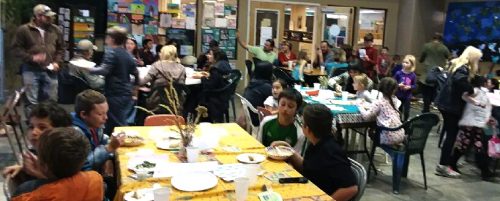









Thirty pounds of carrots and forty pounds of potatoes sat in our fridge. Baskets of onions lined the shelves. These were the rewards of hard planting and harvesting work.
And now what?
Discussions about our intentions began. This is a school that shares nutritious food with students and the food bank. It is also a school that sells produce in preparation for springtime costs. Should we share the rest? Should we sell it? We considered our character focus for the year: collaboration, care and confidence. In what way could we further involve these values with our food?
From these questions and others sprung the idea: a harvest festival. Students would feed their families as they had fed themselves and the community for months. They would prepare food and the environment, they would serve, set-up, greet, grocery shop and clean. But first thing first: they would witness this practice in action.
A small group of students attended Loaves and Fishes free lunch hosted downtown every Thursday. They took note of the details (a posted menu, a dessert cart, music, a coat rack, greeters, servers, food to take home), enjoyed a meal, and then returned to school to share what they witnessed. Alongside teachers, they mapped out the number of roles required to pull off a meal that would serve at least 120 people, and then got to work.
For two weeks students worked collaboratively in small groups on table settings, potato peeling, carrot washing, menu writing and decorations. Students used knives – many for the first time – to chop herbs, garlic, squash and nuts. They blended apples into apple sauce and tasted soups for salt. Fourth-graders cautioned kindergartners around the hot griddle that busily seared dates for a salad; and second-graders voluntarily skipped their recesses to scoop seeds out of dozens of butternut squash. When the day came and parents, community members, siblings and friends began filtered through the door, students easily stepped into their roles as hosts: seating guests and serving bowls of salad and salad, cups of apple sauce, slices of bread and pie. When asked if he was ready to eat yet, Oliver (one of our dedicated servers) declined. “There are still more people waiting to eat! I’ll eat last.”
On this day, PPOS students served more than 200 people lunch, and sent home leftovers for those at home who were unable to attend. Then they came to me, dissatisfied.
“I didn’t even get to do anything to help,” Brenna said. Even after I pointed out the multiple cooking jobs she participated in she said, “I know. But I wanted to do more.” This message rippled through each group of students, who reflected on their work and agreed: they all wished for more participation.
Through this process I saw the values of this school and these students in practice: they cared deeply for those they served, they confidently took on and completed a huge project – and they made it happen while working together.
Below are links to the recipes used for our harvest meal inspiration:
https://www.bonappetit.com/recipe/potato-leek-soup-with-cheese
https://www.allrecipes.com/recipe/51301/sarahs-applesauce/
https://www.bonappetit.com/recipe/shaved-carrots-with-charred-dates
https://www.myrecipes.com/recipe/butternut-soup-coconut-milk
https://www.foodandwine.com/recipes/creamy-balsamic-chive-greek-yogurt-vinaigrette
https://tasty.co/recipe/no-bake-pumpkin-cheesecake


This project took an interdisciplinary approach to learning. This work reflected standards in the following ways:
- Students collaborate effectively as group members or leaders who listen actively and respectfully pose thoughtful questions, acknowledge the ideas of others, and contribute ideas to further the group’s attainment of an objective
- Students deliver organized and effective oral presentations for diverse audiences and varied purposes
- Students use language appropriate for purpose and audience
- Students develop an understanding of fractions, beginning with unit fractions. Students view fractions in general as being built out of unit fractions, and they use fractions along with visual fraction models to represent parts of a whole.
- Students identify the structure and properties of our number system. At their most basic level numbers are abstract symbols that represent real-world quantities
- Students identify quantity through estimation, precision, order of magnitude, and comparison.
- Students practice rights, roles, and responsibilities of citizen.
- Students Develop spatial understanding, perspectives, and personal connections to the world.
- Colorado State Standards: Reading, Writing, Oral Language – Mathematics – Social Studies

